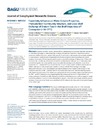Identificador persistente para citar o vincular este elemento:
https://accedacris.ulpgc.es/jspui/handle/10553/31718
| Campo DC | Valor | idioma |
|---|---|---|
| dc.contributor.author | Morales, C. | en_US |
| dc.contributor.author | Anabalón, V. | en_US |
| dc.contributor.author | Bento, J. | en_US |
| dc.contributor.author | Hormazábal Fritz, Samuel | en_US |
| dc.contributor.author | Cornejo, M. | en_US |
| dc.contributor.author | Correa Ramírez, Marco | en_US |
| dc.contributor.author | Silva, N. | en_US |
| dc.date.accessioned | 2018-03-05T09:07:24Z | - |
| dc.date.available | 2018-03-05T09:07:24Z | - |
| dc.date.issued | 2017 | en_US |
| dc.identifier.issn | 2169-9275 | en_US |
| dc.identifier.uri | https://accedacris.ulpgc.es/handle/10553/31718 | - |
| dc.description.abstract | In eastern boundary current systems (EBCSs), submesoscale to mesocale variability contributes to cross-shore exchanges of water properties, nutrients, and plankton. Data from a short-term summer survey and satellite time series (January–February 2014) were used to characterize submesoscale variability in oceanographic conditions and phytoplankton distribution across the coastal upwelling and coastal transition zones north of Punta Lavapié, and to explore cross-shelf exchanges of diatom taxa. A thermohaline front (FRN-1) flanked by a mesoscale anticyclonic intrathermocline eddy (ITE-1), or mode-water eddy, persisted during the time series and the survey was undertaken during a wind relaxation event. At the survey time, ITE-1 contributed to an onshore intrusion of warm oceanic waters (southern section) and an offshore advection of cold coastal waters (northern section), with the latter forming a cold, high chlorophyll-a filament. In situ phytoplankton and diatom biomasses were highest at the surface in FRN-1 and at the subsurface in ITE-1, whereas values in the coastal zone were lower and dominated by smaller cells. Diatom species typical of the coastal zone and species dominant in oceanic waters were both found in the FRN-1 and ITE-1 interaction area, suggesting that this mixture was the result of both offshore and onshore advection. Overall, front-eddy interactions in EBCSs could enhance cross-shelf exchanges of coastal and oceanic plankton, as well as sustain phytoplankton growth in the slope area through localized upward injections of nutrients in the frontal zone, combined with ITE-induced advection and vertical nutrient inputs to the surface layer. | en_US |
| dc.language | eng | en_US |
| dc.relation.ispartof | Journal of geophysical research. Oceans | en_US |
| dc.source | Journal of Geophysical Research - Oceans [ISSN 2169-9275], v. 122 (11), p. 8944-8965 | en_US |
| dc.subject | 2510 Oceanografía | en_US |
| dc.subject.other | Coastal upwelling | en_US |
| dc.subject.other | Cross-shelf exchange | en_US |
| dc.subject.other | Diatom taxa | en_US |
| dc.subject.other | Eastern South Pacific | en_US |
| dc.subject.other | Frontal zone | en_US |
| dc.subject.other | Mesoscale eddies | en_US |
| dc.subject.other | Nutrient distribution | en_US |
| dc.subject.other | Phytoplankton community structure | en_US |
| dc.title | Front-eddy influence on water column properties, phytoplankton community structure, and cross-shelf exchange of diatom taxa in the shelf-slope area off concepción (∼36–37°S) | en_US |
| dc.type | info:eu-repo/semantics/Article | en_US |
| dc.type | Article | es |
| dc.type | Article | es |
| dc.identifier.doi | 10.1002/2017JC013111 | |
| dc.identifier.scopus | 85034604896 | |
| dc.identifier.isi | 000418089400034 | - |
| dc.identifier.url | http://api.elsevier.com/content/abstract/scopus_id/85034604896 | - |
| dc.contributor.orcid | #NODATA# | en |
| dc.contributor.orcid | #NODATA# | en |
| dc.contributor.orcid | #NODATA# | en |
| dc.contributor.orcid | #NODATA# | en |
| dc.contributor.orcid | #NODATA# | en |
| dc.contributor.orcid | #NODATA# | en |
| dc.contributor.orcid | #NODATA# | en |
| dc.contributor.orcid | #NODATA# | en |
| dc.contributor.orcid | #NODATA# | en |
| dc.contributor.orcid | #NODATA# | en |
| dc.contributor.orcid | #NODATA# | en |
| dc.contributor.orcid | #NODATA# | en |
| dc.contributor.authorscopusid | 7202530981 | |
| dc.contributor.authorscopusid | 22978450900 | |
| dc.contributor.authorscopusid | 57197755534 | |
| dc.contributor.authorscopusid | 6602942522 | |
| dc.contributor.authorscopusid | 22978941300 | |
| dc.contributor.authorscopusid | 57212122354 | |
| dc.contributor.authorscopusid | 7102800070 | |
| dc.identifier.eissn | 2169-9291 | - |
| dc.description.lastpage | 8965 | - |
| dc.identifier.issue | 11 | - |
| dc.description.firstpage | 8944 | - |
| dc.relation.volume | 122 | - |
| dc.investigacion | Ciencias | en_US |
| dc.source.type | ar | en |
| dc.type2 | Artículo | en_US |
| dc.contributor.daisngid | 32207330 | |
| dc.contributor.daisngid | 4383324 | |
| dc.contributor.daisngid | 5096640 | |
| dc.contributor.daisngid | 1084777 | |
| dc.contributor.daisngid | 1975269 | |
| dc.contributor.daisngid | 2313528 | |
| dc.contributor.daisngid | 2907180 | |
| dc.contributor.wosstandard | WOS:Morales, CE | |
| dc.contributor.wosstandard | WOS:Anabalon, V | |
| dc.contributor.wosstandard | WOS:Bento, JP | |
| dc.contributor.wosstandard | WOS:Hormazabal, S | |
| dc.contributor.wosstandard | WOS:Cornejo, M | |
| dc.contributor.wosstandard | WOS:Correa-Ramirez, MA | |
| dc.contributor.wosstandard | WOS:Silva, N | |
| dc.date.coverdate | Noviembre 2017 | |
| dc.identifier.ulpgc | Sí | es |
| dc.description.jcr | 2,711 | |
| dc.description.jcrq | Q1 | |
| item.fulltext | Con texto completo | - |
| item.grantfulltext | open | - |
| Colección: | Artículos | |
Citas SCOPUSTM
12
actualizado el 08-jun-2025
Citas de WEB OF SCIENCETM
Citations
10
actualizado el 08-jun-2025
Visitas
114
actualizado el 12-jul-2025
Descargas
194
actualizado el 12-jul-2025
Google ScholarTM
Verifica
Altmetric
Comparte
Exporta metadatos
Los elementos en ULPGC accedaCRIS están protegidos por derechos de autor con todos los derechos reservados, a menos que se indique lo contrario.
